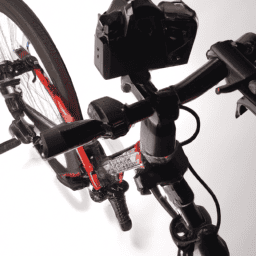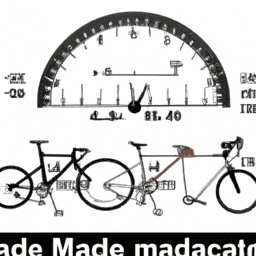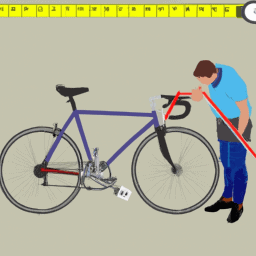Hello, bike lovers! Are you interested in selling your bike on the internet but are unsure of how to begin? Fear not, I’m here to help you out.
As someone who has sold multiple bikes online, I understand the process can be overwhelming, especially if you’re a first-timer. However, with the right approach, you can successfully sell your bike and even make a profit.
In this article, I’ll be sharing my personal experience and tips on how to sell a bicycle online. From assessing your bike’s condition to choosing the right platform to sell on, I’ll guide you through the process step by step.
By the time you finish reading this article, you’ll have a clear understanding of how to sell your bike online effectively and efficiently. So, let’s get started!
Key Takeaways
- Assessing the bike’s condition and fixing minor issues can increase its appeal and value to potential buyers.
- Choosing the right platform and creating a compelling listing that highlights the bike’s unique features and benefits can help attract buyers.
- Negotiating price should be done professionally and respectfully, while still being flexible and realistic to attract buyers while getting a fair price.
- Ensuring clear communication and understanding of payment and shipping arrangements is crucial to a successful transaction.
Assess Your Bike’s Condition
You’ll want to take a close look at your bike’s condition before selling it online. This means inspecting components such as the brakes, gears, and wheels to make sure they’re all working properly. If there are any minor issues, it’s a good idea to fix them before listing your bike for sale. This not only improves the appeal of your bike to potential buyers, but it also increases its value.
When inspecting your bike, pay attention to any wear and tear on the frame and make sure there aren’t any cracks or dents. Check the tires for any signs of wear and make sure they’re properly inflated. Additionally, giving your bike a good cleaning can also make it more attractive to buyers.
By taking the time to assess your bike’s condition and fix any minor issues, you’ll set yourself up for a successful sale. Now, let’s move on to determining your bike’s worth.
Determine Your Bike’s Worth
If you’re unsure of the value of your bike, it might be helpful to get an appraisal from a professional bike shop or mechanic. They can assess your bike’s condition and provide an estimate of its worth.
However, if you want to determine your bike’s value yourself, start by researching comparables. Look for bikes of the same make, model, and year, and compare their condition, mileage, and any modifications or upgrades. This will give you a general idea of what your bike is worth in the current market.
Once you have a ballpark figure, be prepared to negotiate price with potential buyers. Remember to be realistic and flexible, as you want to attract buyers while still getting a fair price for your bike. Keep in mind that some buyers may try to haggle, so be prepared to stand your ground or make a counteroffer.
With a little research and negotiation skills, you can determine the value of your bike and set a fair asking price when you choose a platform to sell on.
Choose a Platform to Sell On
When it comes to selling my bike online, I need to choose the right platform to reach the right buyers. That’s why I’m considering eBay, Craigslist, and specialized bike marketplaces.
eBay is a popular choice for selling bikes because of its wide reach and auction-style format. Craigslist is great for local sales and connecting with buyers in my area. And for a more targeted audience, specialized bike marketplaces like Pinkbike or The Pro’s Closet might be the best option.
With these platforms in mind, I can choose the one that best suits my needs and get my bike sold quickly and easily.
eBay
Hey, selling your bike on eBay is an absolute breeze! As someone who’s sold multiple bikes on this platform, I highly recommend it for anyone looking to maximize their profits.
Here are three reasons why:
-
Wide audience: eBay has a huge customer base, which means your bike listing has the potential to reach a larger audience than other platforms. This also means that you have the opportunity to negotiate a higher price for your bike if there are multiple interested buyers.
-
Easy listing process: eBay has a user-friendly listing process that guides you through every step of the process, from taking photos to setting a price. You can also choose to set a reserve price to ensure that your bike sells for a price that you’re comfortable with.
-
Protection for both buyers and sellers: eBay offers protection for both buyers and sellers in case of any disputes or issues that may arise during the transaction. This gives both parties peace of mind and helps ensure a smooth and successful sale.
Now, if you prefer a more local approach to selling your bike, you might want to consider using Craigslist.
Craigslist
Looking for a more local option to unload your bike? Craigslist might be the way to go. One of the biggest advantages of selling on Craigslist is that it allows you to connect with buyers in your community, making the transaction more convenient for both parties.
However, it’s important to ensure safety when meeting up with potential buyers. Always arrange to meet in a public place, preferably during the day, and bring a friend or family member with you. Trust your instincts and if something feels off, don’t hesitate to back out.
Another thing to keep in mind when selling on Craigslist is to avoid scams. Be wary of any buyers who offer to pay more than the asking price, as this is often a red flag for a scam. Additionally, be cautious of buyers who ask for personal information or payment before seeing the bike in person.
When negotiating prices, be firm but reasonable, and don’t be afraid to say no to lowball offers. Lastly, be prompt in managing inquiries and responding to potential buyers, as this can help build trust and increase the likelihood of a successful sale.
Transitioning into the subsequent section about specialized bike marketplaces, it’s important to note that while Craigslist can be a great option for selling a bike locally, it may not be the best choice for selling specialized or high-end bikes. In the next section, we’ll explore some specialized bike marketplaces that may be more suitable for selling bikes with unique features or a higher price point.
Specialized Bike Marketplaces
If you’re searching for a platform to reach a more specific audience for your bike, you might want to consider the specialized bike marketplaces that cater to your bike’s unique features and potential buyers. Some of the top competitors in this market include Pinkbike, BikeExchange, and Bicycle Blue Book.
Pinkbike is a popular online marketplace that specializes in mountain bikes, while BikeExchange caters to road bikes and commuters. Bicycle Blue Book offers a unique feature where sellers can get an estimated value for their bike based on its condition and other factors.
Each of these specialized bike marketplaces has its pros and cons. While Pinkbike and BikeExchange offer a large audience, they also have a lot of competition from other sellers. Bicycle Blue Book, on the other hand, offers a unique feature that can help sellers price their bike appropriately, but the site may not have as large of an audience as the other two.
Ultimately, it’s important to do your research and choose the marketplace that best fits your bike’s unique features and your sales goals.
When it comes to selling your bike online, choosing the right marketplace is just the first step. Now that you’ve found a platform to reach your target audience, it’s time to create a compelling listing that will grab buyers’ attention.
Create a Compelling Listing
Believe it or not, you’ll want to make your bike sound like it’s the greatest thing since sliced bread in your listing. Highlighting features that make it stand out from the crowd and effective communication are key in creating a compelling listing that will catch the eye of potential buyers.
To start, create a table that showcases your bike’s features and benefits. This will help evoke emotion in your audience and make them more likely to make a purchase. Here’s an example:
| Feature | Benefit | Emotion |
|---|---|---|
| Lightweight frame | Easy to maneuver | Freedom |
| Shimano gears | Smooth shifting | Confidence |
| Disc brakes | Reliable stopping power | Safety |
| Comfortable seat | Long rides without discomfort | Comfort |
Incorporating these types of details into your listing will help potential buyers envision themselves enjoying the bike and create a sense of desire. Once you’ve created a compelling listing, it’s time to close the deal and make the sale.
Close the Deal
To effectively close the deal when selling a bicycle online, it’s crucial to be responsive to the buyer’s inquiries. Be prompt in answering their questions, and try to be as accommodating as possible while still protecting your own interests.
Negotiating tactics can come into play, but it’s important to keep the conversation professional and respectful.
When handling inquiries, be sure to provide all the necessary details about the bike. This includes its condition, age, and any accessories or modifications that are included in the sale.
Additionally, be clear about your payment and shipping policies. Once the buyer has agreed to purchase the bike, make sure all necessary paperwork is in order and that you have a clear understanding of the shipping arrangements.
By being communicative and transparent throughout the process, you can ensure a smooth and successful transaction.
Frequently Asked Questions
How do I handle shipping and delivery when selling a bike online?
When selling a bike online, I handle shipping logistics by using a reputable carrier and insuring the bike for its full value. I also take care to package the bike securely and provide clear instructions to avoid damages.
What should I do if a potential buyer wants to negotiate the price?
If a potential buyer wants to negotiate the price, I suggest using negotiation tactics such as highlighting the value of the bike or offering incentives. It’s important to respond to low offers respectfully and find a mutually beneficial solution.
Is it necessary to include a warranty or return policy when selling a bike online?
A warranty adds value and trust in the eyes of the buyer. Be aware of legal considerations when offering returns. Protecting your reputation and providing a positive customer experience can lead to repeat business.
How do I protect myself from scams or fraudulent buyers when selling a bike online?
To protect myself from scams when selling a bike, I verify the buyer’s identity and use secure payment methods. I recommend using a verification process and only accepting payments through secure platforms like PayPal or Venmo.
What are some effective ways to promote my bike listing and attract more potential buyers?
To attract more potential buyers, I use social media marketing to reach a wider audience. I also create email campaigns to target interested parties. It’s all about getting the word out and showcasing the bike’s unique features.
Conclusion
So there you have it – selling a bike online is a breeze if you follow these simple steps.
Assess your bike’s condition, determine its worth, choose a platform to sell on, create a compelling listing, and close the deal.
It may seem daunting at first, but with a little bit of effort and research, you can successfully sell your bike online and make a tidy profit.
Coincidentally, I’ve recently sold my own bike online using these exact steps. It was a bittersweet moment as I watched my trusty two-wheeler ride off into the sunset with its new owner.
But the satisfaction of knowing that I had found it a good home, and pocketed some cash in the process, made it all worth it.
So if you’re looking to sell your bike, don’t hesitate – follow these steps and you’ll be on your way to a successful sale in no time!
















